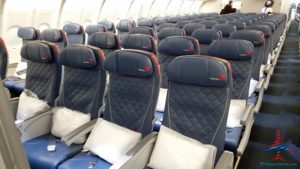Advertiser Disclosure: Eye of the Flyer, a division of Chatterbox Entertainment, Inc., is part of an affiliate sales network and and may earn compensation when a customer clicks on a link, when an application is approved, or when an account is opened. This relationship may impact how and where links appear on this site. This site does not include all financial companies or all available financial offers. Opinions, reviews, analyses & recommendations are the author’s alone, and have not been reviewed, endorsed, or approved by any of these entities. Some links on this page are affiliate or referral links. We may receive a commission or referral bonus for purchases or successful applications made during shopping sessions or signups initiated from clicking those links.
Since it’s a lazy Saturday in May I thought you may really like the above video I found (and a few million others). Now the math and the logic is NOT Delta specific and we can tweak it a bit to focus on our favored airline.
So how does this basic video compare to Delta? They are clearly working to up-sell that “filled up space” into something more. Move anyone from C- to C+ (i.e. by paying for it) and think what a jump in revenue that is. Move them from C- to 1st (or Delta One) and you are talking another big jump no matter how much they charge in the end. With the new large PE cabins it can mean even more money!
Then we have all the other ancillary revenue to get something out of those just taking up space in coach – that is, selling anything like drinks, food etc.
Now there is a clear difference between a domestic and international bid and the selling logic. But sticking with international for a bit we can see why Delta is so “scared to death” from airlines like NAI that is almost solely focused on coach passengers vs. Delta that is not. The rich field of income is truly threatened by an all (or almost all) coach approach model.
What do you think of this little education in aviation income. Agree? Disagree? Any other Delta specific thoughts on the model? Let us know in the comments below! – René
Advertiser Disclosure: Eye of the Flyer, a division of Chatterbox Entertainment, Inc., is part of an affiliate sales network and and may earn compensation when a customer clicks on a link, when an application is approved, or when an account is opened. This relationship may impact how and where links appear on this site. This site does not include all financial companies or all available financial offers. Opinions, reviews, analyses & recommendations are the author’s alone, and have not been reviewed, endorsed, or approved by any of these entities. Some links on this page are affiliate or referral links. We may receive a commission or referral bonus for purchases or successful applications made during shopping sessions or signups initiated from clicking those links.











I disagree with this propaganda video on many of its implicit assumptions and ultimate conclusions. For instance, it assumes all seats on a plane are sold (no award tickets, non-revs and upgrades) and each seat in a class is sold for the same price. It also fails to factor in costs from the revenue produced by each cabin.
Of course Delta has no first class internationally. The video contends business class is the most profitable cabin, but when delta introduces PE on the 777 it will reduce business class more than economy to make room for the huge PE cabin of 48 seats. (My biggest problem with the new seating arrangement is eliminating C+ on a route like JNB-ATL which can be a 17 hour flight with strong headwinds.)
Interesting video. Thanks for posting it. Although it’s not as simple as he makes it seem with fares for different classes, it’s interesting to see a general economic overview of how revenue works for a plane. Sometimes people pay more for a full fare economy ticket than a discounted business or first ticket. Sometimes people use award tickets. There’s also the cargo factor of revenue. At the same time, comparing the classes based on the video’s numbers gives a general idea of how much the airline can make from each class.
Very interesting video.
For the sake of argument, if coach seats are there merely to fill up a plane, at the other end of the spectrum, E Class Tickets serve as a means to generate more dollars from those seats.
For 2018 the cost of a main cabin seat on the route I fly has increased by 11%. But that’s only if I’m willing to suffer with an E Class Ticket. To purchase the same upgradeable coach seats that I had this year, for 2018 the cost has jumped by a whopping 21%.
Realistically, folks who are content to fly on an “all coach” airline probably couldn’t and wouldn’t be flying Delta — or any other premium carrier. These are people who are too cheap to fly United!
That said, nothing in this video is surprising to me. As Business Class — or however different airlines wish to market it — has exploded in popularity, airlines have poured a ton of resources into making their business class better than their competitors. Naturally, first class suffers as business class nears what was traditionally “first class” service.
I for one don’t care. Unless my client is footing the bill for the seat; then I’ve got no problem booking first class. The banks have deep pockets; let them pick up my tab.